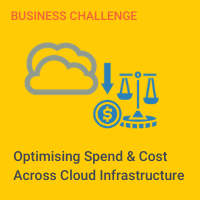
researchHQ’s Key Takeaways:
- When scaling their cloud estates, organisations require a cost optimisation strategy to avoid dramatic wasted spend.
- Daily operational cloud cost optimization is the ideal model for small enterprises, allowing team members to check tools daily and view a prioritized list of cost-saving tasks.
- Cycle-based cloud cost optimization is the ideal model for most large enterprises, enabling teams to aggregate all recommendations and establish optimization cycles.
- Cycle-based optimization consists of four steps: the recognition of resources in place, the assessment of prescriptive recommendations and prioritization of efforts, solution optimization and metric evaluation.
Introduction
At some point in their cloud journey, most organizations hit a major obstacle. After experimenting with a workload or two, organizations begin to scale their cloud investment and estate. It is only then that executives realize they have a problem: their teams lack the skills, tools, and processes they need to track, manage, and optimize expenditures. Consequently, costs rise rapidly and often dramatically exceed budgets and expectations.
In this post, we look at some key strategies and tactics that teams can employ to start optimizing their cloud investments and resources.
Learn more about optimising cloud costs.
Cloud Optimization Models
In pursuing cloud cost and resource optimization, IT and cloud teams can choose from two models:
-
Daily operational optimization
Employing this model, team members will look at tools on a daily basis, and see a prioritized list of tasks for saving costs. Every day, they’ll execute those tasks they can, and then start the process again the next day.
-
Cycle-based optimization
With this model, teams will aggregate all recommendations and establish optimization cycles. These cycles can be based on a range of intervals, typically monthly or bi-monthly. At a high level, the process entails establishing baselines, executing recommended optimization tasks, evaluating and auditing progress, and, at the end of the cycle, establishing new baselines to track progress.
For smaller cloud estates, the daily operational approach is great. On the other hand, for most large enterprises, cycle-based optimization will be the best approach. The following sections offer more details on this cycle-based approach.
Cycle-based Optimization: Four Key Steps
There are 4 steps to cycle-based optimization, which is a continuous process.
Step 1: Recognize.
The first step is for teams to establish an awareness of what resources are in place. This is vital to establish a complete, current picture of all the resources in place—both on premises in and public clouds. Teams should look to establish visibility and insights by business service and application in order to most intelligently determine what resources exist and how they are used. This will serve as an initial baseline for measurement and changes.
Step 2: Analyze.
In this phase, teams assess prescriptive recommendations and prioritize efforts. Tasks should be broken out by service tiers, for example, distinguishing between production, non-production, shared services, and so on. Often, efforts will be prioritized by cost savings. Teams can come up with standard guidelines to help ensure the payoff is aligned with the economic models. For example, guidelines could indicate that those efforts that net savings of $1000 or more are given the highest priority, those less than $1000 will be lower priority, and those less than $100 will not be pursued.
Step 3: Optimize.
The goal of this phase is to ensure the most efficient use of resources and budget. Teams will typically apply a predetermined method for identifying and then implementing optimization recommendations. Optimization recommendations can include options for right-sizing cloud resources, placing intermittently used resources on schedules, and using on-demand, discounted, or spot pricing for purchasing cloud resources.
Step 4: Evaluate.
The last phase is where teams compare metrics against the previously established baseline, calculating actual cost savings realized based on recommendations implemented. In this effort, it is important to establish apples-to-apples comparisons between baselines and current state. This means factoring in changes that may have occurred, for example, accounting for changes in pricing or new instances that may have been provisioned since the baseline was established. Finally, the new metrics gathered then become the new baseline for the next cycle, and the process begins again.








